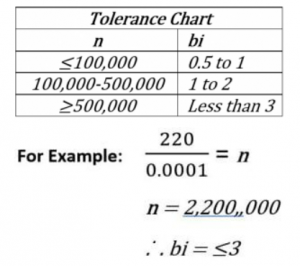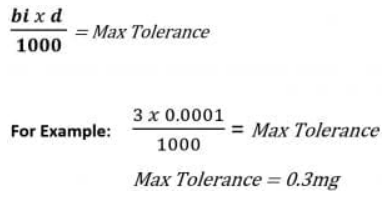How to Determine the Right Tolerance and Class for the Check Weights
Capacity of the Balance – This is the maximum weight in the operational range of your balance (usually displayed on the information plate found on the front or sides of the balance – otherwise please consult the handbook)
Readability – This is the amount of weight information displayed by the balance after the decimal point and the interval by which the information changes (usually displayed on the information plate found on the front or sides of the balance, generally listed as “d =” – otherwise please consult the handbook
For Example: Precisa LT220A
Capacity: 220g max.
Readability: d= 0.0001g
For the purposes of this calculation please convert both of these pieces of information into grams.
- For Kg x 1000
- For mg ÷ 1000
Divide the Capacity of the Balance (g) by the Readability (d), this will give you the Number of Intervals (n). Then using n consult the Tolerance Chart below to work out your Balance Increments (bi)
Then multiply your Balance Increments (bi) by your Readability (d) to give your Max Tolerance
Then find the Nominal Value for your Balance (single Nominal Value ≈ 80-100% Capacity of Balance) using the chart below. Read across until you reach the closest value your Max Tolerance without exceeding the value. The column in which this resides will give you your Weight Class (E1 – M1)
For Example: Max Tolerance = 0.3mg
Nominal Value (Precisa LT220A) = 200g
.͘ . Weight Class = E2
| Nominal Value | E1 | E2 | F1 | F2 | M1 |
| +/- mg | +/- mg | +/- mg | +/- mg | +/- mg | |
| 1 mg | 0,0003 | 0,006 | 0,020 | -0,06 | -u,20 |
| 2 mg | 0,003 | 0,006 | 0,020 | 0,06 | 0,20 |
| S mg | 0,003 | 0,006 | 0,020 | 0,06 | 0,20 |
| 10 mg | 0,003 | 0,008 | 0,025 | 0,08 | 0,25 |
| 20 mg | 0,003 | 0,010 | 0,03 | 0,10 | 0,3 |
| 50 mg | 0,004 | 0,012 | 0,04 | 0,12 | 0,4 |
| 100 mg | 0,005 | 0,016 | 0,0S | -0,16 | 0,S |
| 200 mg | 0,006 | 0,020 | 0,06 | 0,20 | 0,6 |
| SOO mg | 0,008 | 0,02S | 0,08 | 0,25 | 0,8 |
| 1 mg | 0,010 | 0,030 | 0,10 | 0,3 | 1,0 |
| -2 g | 0,012 | 0,040 | 0,12 | 0,4 | 1,2 |
| S g | 0,016 | 0,050 | 0,16 | 0,5 | 1,6 |
| 10 g | 0,020 | 0,060 | 0,20 | 0,6 | 2,0 |
| 20 g | O,Q2S | 0,080 | 0,25 | 0,8 | 2,5 |
| 50 g | 0,030 | 0,10 | 0,3 | 1,0 | 3,0 |
| 100 g | O,OS | 0,16 | 0,5 | 1,6 | 5 |
| 200 g | 0,10 | 0,30 | 1,0 | 3,0 | 10 |
| 500 g | 0,25 | 0,80 | 2,5 | 8,0 | 25 |
| 1 kg | 0,5 | 1,6 | 5 | 16 | 50 |
| 2 kg | 1,0 | 3,0 | 10 | 30 | 100 |
| 5 kg | 2,S | 8,0 | 25 | 80 | 250 |
| 10 kg | 5 | 15 | 50 | 160 | 500 |
| 20 kg | 10 | 30 | 100 | 300 | 1,000 |
| 50 kg | 2S | 80 | 250 | 800 | 2,500 |
Number/Values of Test Weights Required
Using the information from above you have determined the Weight Class requirement for your check weights. You can now decide which weight(s) from that class are required to monitor the performance of your balance.
Cursory Testing – for non-critical balances (Single Weight):
The nominal value of the external calibration weight is often used for this purpose (consult the user guide or operating software of your balance).
A single weight close to the capacity of the balance can be used if the balance is used throughout the range. If the balance is used for a single test with a specific target weight then a single check weight on or close to that value can be used.
Complete Testing – for critical balances (Multiple Weights):
Used to check the weighing range comprehensively
Using single weights the following four test loads are recommended: ≈ 25%, 50%, 75% and 100% (or at least 80%) of the maximum rated capacity.
The test weight for 100% (or at least 80%) of the maximum rated capacity should consist of just one weight, rather than a combination of several test weights.
Keep in Touch
For more information on balance readability, why not get in touch with a member of our team by contacting them at info@precisa.ch, and to be the first to see the latest news and product info, follow us on social media.






